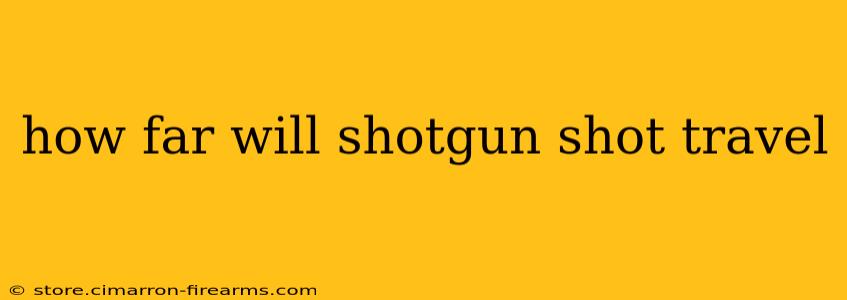The question "How far will shotgun shot travel?" doesn't have a simple answer. It depends on several crucial factors, making it a complex topic for both hunters and firearm enthusiasts. This guide will delve into the physics of shotgun shot dispersion, influencing factors, and the practical implications for safe and effective shooting.
Factors Affecting Shotgun Shot Travel Distance
Several interconnected variables determine how far shotgun pellets will travel:
-
Gauge: The gauge of the shotgun (e.g., 12-gauge, 20-gauge) directly impacts the shell's size and the amount of shot it carries. Larger gauges generally propel shot farther due to increased powder charge and pellet weight.
-
Choke: The choke of the shotgun barrel constricts the shot pattern. A tighter choke (e.g., full choke) concentrates the shot, increasing range but potentially reducing pattern density at closer ranges. Conversely, a more open choke (e.g., cylinder bore) produces a wider pattern with less range but better close-range effectiveness.
-
Shot Size: Smaller shot sizes (e.g., #8, #9) are lighter and more susceptible to wind drift, resulting in shorter effective range compared to larger shot sizes (e.g., #4, #00). Larger shot retains more energy at longer distances.
-
Powder Charge: A higher powder charge will increase the velocity of the shot, extending its range. However, this also impacts recoil and potentially the shooter's accuracy.
-
Ammunition Quality: The quality of the ammunition itself, including the shot's uniformity, powder consistency, and wad design, significantly impacts performance and range. Premium ammunition often delivers superior results.
-
Environmental Conditions: Wind speed and direction, temperature, and even humidity can affect the shot's trajectory and effective range. Headwinds will reduce range, while tailwinds can extend it.
Effective Range vs. Maximum Range
It's crucial to differentiate between effective range and maximum range.
-
Maximum Range: This refers to the theoretical maximum distance a shot pellet can travel. This distance is often irrelevant in practical shooting scenarios due to significant pellet drop, dispersion, and energy loss.
-
Effective Range: This is the distance at which a shooter can reliably hit their target with a sufficient number of pellets to cause damage or incapacitation. This range varies greatly depending on the factors listed above and the size of the target.
For hunting purposes, effective ranges are usually much shorter than maximum ranges. For example, while a shotgun pellet might travel a considerable distance, its energy at those distances might be insufficient to reliably kill game, and the wide dispersion makes accurate hits improbable.
Practical Considerations for Safe Shotgun Handling
Understanding shotgun shot travel is paramount for safe gun handling:
-
Beyond Effective Range: Shooting beyond the effective range of your shotgun is not only inefficient but also unsafe. Lost pellets can travel unexpectedly long distances, posing risks to unintended targets.
-
Backstop: Always ensure a safe backstop is in place when shooting. This prevents stray pellets from causing damage or injury.
-
Awareness of Surroundings: Be fully aware of your surroundings and potential hazards before discharging a shotgun.
Conclusion: No Single Answer, But Informed Decisions
There's no single definitive answer to "How far will shotgun shot travel?" The distance varies dramatically depending on several interdependent factors. Understanding these factors is vital for safe and effective shotgun use, allowing for informed decisions regarding ammunition selection, choke selection, and responsible shooting practices. Always prioritize safety and practice responsible gun ownership.

